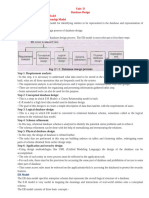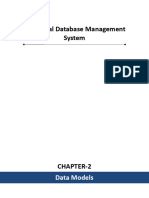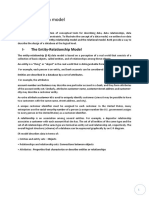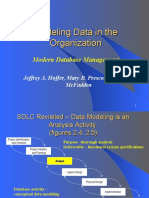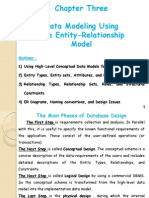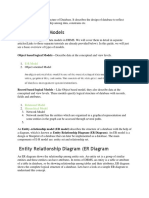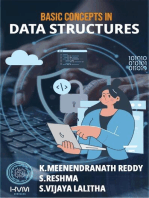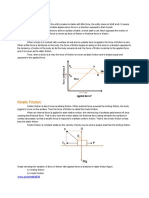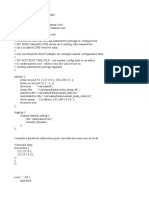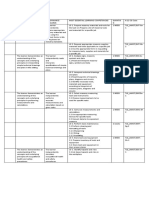Quiz ERD
Quiz ERD
Uploaded by
Kawai NezukoCopyright:
Available Formats
Quiz ERD
Quiz ERD
Uploaded by
Kawai NezukoOriginal Title
Copyright
Available Formats
Share this document
Did you find this document useful?
Is this content inappropriate?
Copyright:
Available Formats
Quiz ERD
Quiz ERD
Uploaded by
Kawai NezukoCopyright:
Available Formats
Here are the notes for the quiz based on the provided lecture:
1. ER Modeling and Database Systems
- Entity-relationship (ER) modeling is a technique used for conceptual database modeling.
- It helps structure and organize the requirements collection process.
- ER modeling provides a graphical representation of the database requirements.
- An ER diagram serves as a blueprint for the database.
2. Entities and Attributes
- Entities represent the constructs that the database keeps track of.
- Entities can be people, places, objects, events, items, or other concepts.
- Each entity must have a unique name within the ER diagram.
- Entity instances are the occurrences of an entity and are recorded in the database.
- Attributes are characteristics of an entity and represent the details recorded for each entity
instance.
- Each attribute within an entity must have a different name.
- Regular entities must have at least one unique attribute.
3. Relationships and Cardinalities
- Relationships depict how entities are related to each other.
- Each entity in an ER diagram must be related to at least one other entity via a relationship.
- Cardinality constraints define how many instances of one entity can be associated with
instances of another entity.
- Maximum cardinality can be one (represented by a straight bar: I) or many (represented by
a crow's foot symbol).
- Minimum cardinality represents participation and can be optional (0) or mandatory
(represented by a straight bar: I).
- Types of relationships include one-to-one (1:1), one-to-many (1:M), and many-to-many
(M:N) relationships.
4. Relationship Instances and Attributes
- Relationship instances occur when an instance of one entity is related to an instance of
another entity via a relationship.
- Relationship instances are recorded in the database.
- Some relationships, such as M:N relationships, can have their own attributes.
5. Composite Attributes and Multivalued Attributes
- Composite attributes are composed of several attributes and indicate a situation where a
collection of attributes has additional meaning.
- Composite unique attributes are composed of several attributes and have different values
for each entity instance.
- Entities can have multiple unique attributes, also known as candidate keys.
- Multivalued attributes allow instances of an entity to have multiple values for the same
attribute.
6. Derived Attributes and Optional Attributes
- Derived attributes are calculated and not permanently stored in the database.
- Optional attributes are allowed to have no value.
7. Weak Entities and Identifying Relationships
- Weak entities do not have a unique attribute of their own.
- Weak entities are associated with their owner entities via an identifying relationship.
- Identifying relationships can be 1:M or 1:1 relationships.
- Weak entities have a partial key attribute that, combined with the unique attribute of the
owner entity, uniquely identifies their instances.
8. Naming Conventions for ER Diagrams
- Entities and attributes should use singular nouns.
- Relationships should use verbs or verb phrases.
- Names should be brief but not too condensed to obscure the meaning.
- Different names should be given to all attributes in the ER diagram, if possible.
9. Database Requirements and ER Model Usage
- ER modeling helps collect, structure, and visualize requirements.
- It is crucial for creating ER models and helps in the requirements collection process.
- Mistakes to avoid include confusing entities with the ER diagram itself and modeling
unfeasible requirements.
10. Various ER Notations
- There is no universally adopted ER notation, but there are several available notations.
- Familiarity with one ER notation makes it easy to understand and use alternative notations.
These notes cover the main concepts and topics discussed in the lecture on Database
Requirements and ER Modeling.
You might also like
- The Best Engineer Skills MatrixDocument2 pagesThe Best Engineer Skills MatrixKazi Yasin Islam100% (1)
- Data Structures & Algorithms Interview Questions You'll Most Likely Be AskedFrom EverandData Structures & Algorithms Interview Questions You'll Most Likely Be AskedRating: 1 out of 5 stars1/5 (1)
- Enity DBMSDocument16 pagesEnity DBMSabhishek singhNo ratings yet
- w4l1 - Er ModelDocument56 pagesw4l1 - Er ModelMiguel Carlo GuillermoNo ratings yet
- Brief Introduction To Database Concepts: Andrea Rodr Iguez Summer School - Castell On 2004Document16 pagesBrief Introduction To Database Concepts: Andrea Rodr Iguez Summer School - Castell On 2004Prashant TajaneNo ratings yet
- P2-DataModel-ER ModelDocument23 pagesP2-DataModel-ER Modelsimonkp.liveNo ratings yet
- DBMS Unit2 PrintDocument40 pagesDBMS Unit2 Printarumuganainar1801No ratings yet
- Business-Database Management SystemDocument24 pagesBusiness-Database Management SystemAmer Ahmed KhanNo ratings yet
- Dbms EntityDocument40 pagesDbms Entityvu4f2223087No ratings yet
- E-R ModelDocument14 pagesE-R Modelkiller HackingNo ratings yet
- Pod NotesDocument29 pagesPod NotesSachin KondawarNo ratings yet
- Lecture 2Document50 pagesLecture 2Vasudevan JanarthananNo ratings yet
- VND - Openxmlformats Officedocument - Presentationml.presentation&rendition 1 2Document42 pagesVND - Openxmlformats Officedocument - Presentationml.presentation&rendition 1 2fashion20trendsNo ratings yet
- Lecture 3Document60 pagesLecture 3Tan Hui HuiNo ratings yet
- UNIT-2: Entanty InstanceDocument23 pagesUNIT-2: Entanty InstanceSreeram RaoNo ratings yet
- Unit 2Document32 pagesUnit 2JenifusNo ratings yet
- WINSEM2023-24 BCSE302L TH CH2023240502444 Reference Material II 12-01-2024 Mod 2 ERMODELDocument87 pagesWINSEM2023-24 BCSE302L TH CH2023240502444 Reference Material II 12-01-2024 Mod 2 ERMODELsarvesh.vitchennaiNo ratings yet
- DB Lect 5Document7 pagesDB Lect 5pintumaharana988No ratings yet
- Entity Relationship ModelDocument5 pagesEntity Relationship Modelnayan moni dasNo ratings yet
- Data or ER ModelsDocument63 pagesData or ER ModelsPep JorghinoNo ratings yet
- DBMS-lecture 4 ER-Model IntroductionDocument14 pagesDBMS-lecture 4 ER-Model IntroductionMonica TimberNo ratings yet
- Lecture 5 ER ModelingDocument21 pagesLecture 5 ER ModelingMalik Adnan JaleelNo ratings yet
- Topic 3 - Database DesignDocument15 pagesTopic 3 - Database DesignRichard KyuliNo ratings yet
- Lecture05 IDBDocument27 pagesLecture05 IDBmahfuzarnab21No ratings yet
- Unit 2Document41 pagesUnit 2adityahada00No ratings yet
- ER Diagram RepresentationDocument21 pagesER Diagram RepresentationOwen LuzNo ratings yet
- Database SystemsDocument103 pagesDatabase Systemsanoophiremath986No ratings yet
- Unit-I Part 2 ER Models PDFDocument32 pagesUnit-I Part 2 ER Models PDFAman MugutNo ratings yet
- The Entity-Relationship ModelDocument18 pagesThe Entity-Relationship ModelSaloni NandaNo ratings yet
- Assignment 4. Data Modeling.Document2 pagesAssignment 4. Data Modeling.Lindsay Fitzgerald100% (3)
- Entity Relationship Data ModellingDocument13 pagesEntity Relationship Data ModellingSamuel NdiranguNo ratings yet
- Using ERwin Data ModelerDocument46 pagesUsing ERwin Data Modelerapi-3814149100% (1)
- 206-Manasi Bonde-EXPERIMENT NO 1Document10 pages206-Manasi Bonde-EXPERIMENT NO 1Manasi BondeNo ratings yet
- DB Ch07Document63 pagesDB Ch07Hessa TotaNo ratings yet
- Data Models Unit 1Document72 pagesData Models Unit 1Faisal Nazir (ANDY)No ratings yet
- Basics of ER-ModelDocument7 pagesBasics of ER-ModelTejaswini BeriNo ratings yet
- DBMS (Unit II)Document33 pagesDBMS (Unit II)Abhay KNo ratings yet
- Unit-2 DbmsDocument28 pagesUnit-2 DbmsAnkitaNo ratings yet
- INTRODUCTION OF INFO SYSTEM InsamDocument76 pagesINTRODUCTION OF INFO SYSTEM InsamEkobe blaiseNo ratings yet
- Database Management SystemsDocument85 pagesDatabase Management Systemsbogdan2303No ratings yet
- Chapter 2: Data Model: I-The Entity-Relationship ModelDocument48 pagesChapter 2: Data Model: I-The Entity-Relationship ModelAWAHNJI JEAN100% (1)
- Database Management System4Document16 pagesDatabase Management System4YaminiNo ratings yet
- High-Level Conceptual Data Models For Database Design: Unit - 2 Data Modelling Using Entity-Relationship ModelDocument17 pagesHigh-Level Conceptual Data Models For Database Design: Unit - 2 Data Modelling Using Entity-Relationship Modelcp54609No ratings yet
- What Is ER DiagramDocument5 pagesWhat Is ER DiagramArshadNo ratings yet
- Er DiagramDocument42 pagesEr DiagramkavithaNo ratings yet
- Lec 2 Data Modeling and Database DesignDocument10 pagesLec 2 Data Modeling and Database DesignJeffrey Fernandez PapaNo ratings yet
- Modeling Data in The OrganizationDocument41 pagesModeling Data in The OrganizationNandita RameshNo ratings yet
- ER Model 3Document17 pagesER Model 3Adhil Ashik vNo ratings yet
- DBMS (R20) Unit - 3Document67 pagesDBMS (R20) Unit - 3jamalayya841No ratings yet
- Entity Relationship Diagram 2Document32 pagesEntity Relationship Diagram 2francisNo ratings yet
- FDatabase Ch3Document19 pagesFDatabase Ch3Ali Abdulrahim ZakhoNo ratings yet
- Unit 2Document26 pagesUnit 2laket64875No ratings yet
- Airport Mangement SystemDocument11 pagesAirport Mangement SystemHarsh tandelNo ratings yet
- System Analysis and Design - Lect6Document27 pagesSystem Analysis and Design - Lect6abasioduchadumorenNo ratings yet
- Data ModelDocument9 pagesData ModelsuvadarshiniswainNo ratings yet
- Lecture 2 - DB - ERDDocument46 pagesLecture 2 - DB - ERDMohamed AdelNo ratings yet
- Database EnglishDocument8 pagesDatabase Englishrekogoy789No ratings yet
- Data Models - ER2Document48 pagesData Models - ER2Rohan jhaNo ratings yet
- Data Models 2Document45 pagesData Models 2VenuNo ratings yet
- Transmigrated As A Ger To Farm - FoxaholicDocument1 pageTransmigrated As A Ger To Farm - FoxaholicokundigiecynthiaNo ratings yet
- Software Project Management: Session 7: Risk and Change ManagementDocument41 pagesSoftware Project Management: Session 7: Risk and Change Managementnam30091996No ratings yet
- Hyundai Hd65 Hd72 Hd78 Electrical Troubleshooting ManualDocument10 pagesHyundai Hd65 Hd72 Hd78 Electrical Troubleshooting Manualjacquiline100% (60)
- 2017 HSC MultimediaDocument10 pages2017 HSC Multimediathrowawayacc4455No ratings yet
- Web Disp Step by Step DocuDocument29 pagesWeb Disp Step by Step DocuAdeel Khan100% (2)
- 15 Essential Project Officer Skills For Your Resume and CareerDocument12 pages15 Essential Project Officer Skills For Your Resume and CareersafiullahNo ratings yet
- 9 Distance Measures in Data ScienceDocument9 pages9 Distance Measures in Data ScienceAmmar NajjarNo ratings yet
- Department of EducationDocument25 pagesDepartment of EducationjajalarawanNo ratings yet
- Belimo Piv Brochure En-UsDocument8 pagesBelimo Piv Brochure En-UsJoão AlvesNo ratings yet
- VM 50 TsDocument4 pagesVM 50 TspoongodiskNo ratings yet
- Grade 10 - Unit 06Document7 pagesGrade 10 - Unit 06UmayangaNo ratings yet
- Intelligent Transport Systems of Singapore:: An Introductory Resource For Aspiring Chartered EngineersDocument52 pagesIntelligent Transport Systems of Singapore:: An Introductory Resource For Aspiring Chartered EngineerssunilarunaNo ratings yet
- Schneider Ul 891 Ul 1558Document6 pagesSchneider Ul 891 Ul 1558Daniel García PNo ratings yet
- INSTRUCTIONS FOR USOL PRIVATE REAPPEAR DE January 2022Document4 pagesINSTRUCTIONS FOR USOL PRIVATE REAPPEAR DE January 2022RaghavNo ratings yet
- Operational Definitions Ans Scales (Chapter 8 9)Document44 pagesOperational Definitions Ans Scales (Chapter 8 9)Môbĭ ShAhNo ratings yet
- FRICTION (Types)Document1 pageFRICTION (Types)Anurag MalikNo ratings yet
- Career Research Paper Example MlaDocument7 pagesCareer Research Paper Example Mlaafmcuafnh100% (1)
- STNW1165ver3 GeneratorDocument67 pagesSTNW1165ver3 GeneratorBuddy EkoNo ratings yet
- Exploring Contributing Factors To Pisa 2022 Mathematics Achievementinsights From Indonesian TeachersDocument18 pagesExploring Contributing Factors To Pisa 2022 Mathematics Achievementinsights From Indonesian TeachersFaaiz DwnvNo ratings yet
- Unit 4 Power Quality Management in Smart Grid Emc - Electromagnetic CompatibilityDocument18 pagesUnit 4 Power Quality Management in Smart Grid Emc - Electromagnetic CompatibilityMathumathi TNo ratings yet
- TP DNSDocument4 pagesTP DNSvasvetNo ratings yet
- Top 50 Tableau Real-Time Interview Questions and Answers PDFDocument11 pagesTop 50 Tableau Real-Time Interview Questions and Answers PDFPandian Nadaar100% (1)
- Detection of 6 Dye Chemistry Amplified Fragments For The SeqStudioDocument11 pagesDetection of 6 Dye Chemistry Amplified Fragments For The SeqStudioCoco VoiceNo ratings yet
- Web LCT - RTN Access IssueDocument10 pagesWeb LCT - RTN Access Issuefelly mutuakashalaNo ratings yet
- About UsDocument16 pagesAbout UsManam BerampuramNo ratings yet
- Melcs 4th Quarter TleDocument1 pageMelcs 4th Quarter TleJonRey GaricaNo ratings yet
- Nema Sm23 - 1991pdfDocument64 pagesNema Sm23 - 1991pdfTritis BatikNo ratings yet
- ATOS Academy - ABCCDocument27 pagesATOS Academy - ABCCceciriNo ratings yet
- Entry Level Civil Engineer Resume PDF DownlaodDocument2 pagesEntry Level Civil Engineer Resume PDF DownlaodManiNo ratings yet















